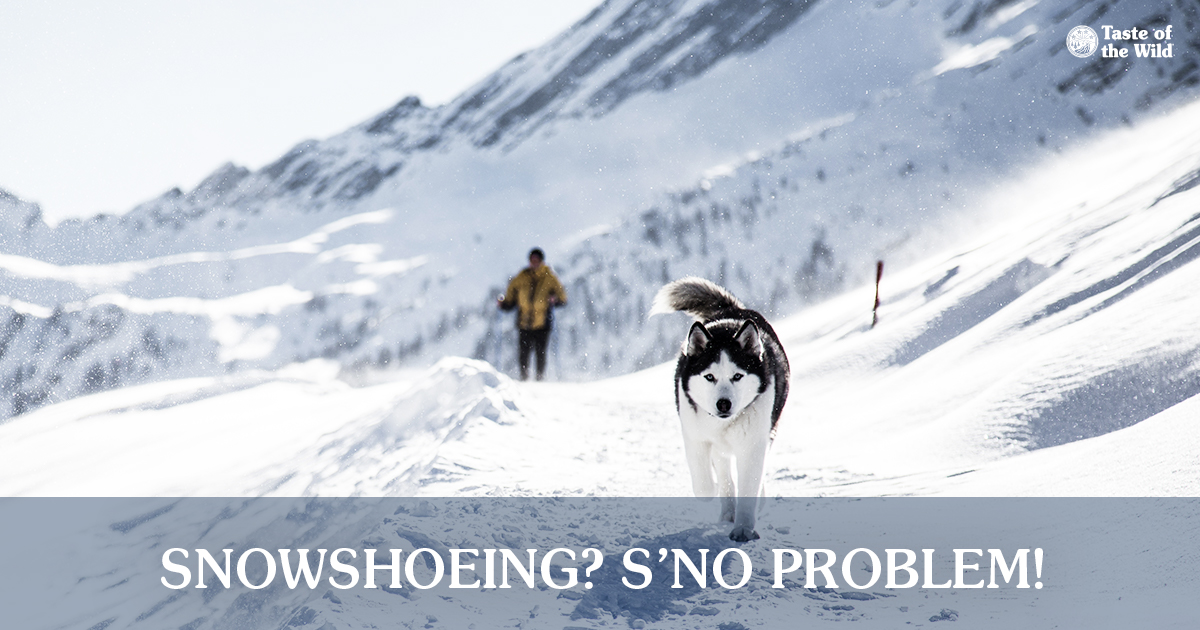
It’s a little like being inside your own, personal snow globe: You on snowshoes, your dog at your side, and snowflakes whirling around you. Whether you want to carve out a trail in the deep woods or mount the snow-capped hills of your local snowmobile trails, here are a few questions to ask yourself before you go:
- Is your dog physically fit? Does your dog go on regular walks or runs with you? If so, great. But if your dog prefers to couch surf or has an underlying medical issue, such as arthritis or a heart condition, or is carrying a little more weight than they should be, talk to your veterinarian. Either way, it’s best to start with shorter snowshoe outings and gradually work up to longer trails to give your dog a chance to build up endurance.
- Will your dog be warm enough? If your dog has short or thin fur, consider an insulated dog coat for an extra layer of warmth. Same goes for puppies and senior dogs, who have a harder time regulating their body temperatures. Avoid cotton jackets, which can become damp and cold from snow.
- Will your dog get cold feet? Before you go, trim the fur between your dog’s paw pads (or better yet, ask a groomer to do it), so snow and ice doesn’t clump there. If you plan on being out for a while, consider applying a balm such as Musher’s Secret to help prevent the paw pads from cracking. If your dog is the tolerant type, booties might do the trick, but make sure they won’t come off in deep snow.
- How will your dog stay hydrated and energized? Bounding through the snow can be physically demanding for your dog. And while there might be streams nearby, the water can be contaminated. Bring fresh water and a collapsible water bowl to quench your dog’s thirst. A small bag of dry dog food may provide needed calories if your dog runs out of energy. Don’t forget to pack poop bags so you can leave the snow in pristine condition.
- Are the snowshoe trails dog friendly? If the trail has been groomed for cross-country skiing, users probably won’t appreciate your dog punching paw holes through the grooved tracks. Before you go, learn the rules about where dogs are welcome.
- What about vertically challenged breeds? Dogs with short legs like dachshunds or Pomeranians can share in the fun, too. Just find a trail where the snow is more packed, so most of their bodies are above the snow.
- Should your dog be leashed? You don’t want your dog to bother other snowshoers, wildlife or other dogs in the area. Better yet, loop a trekking belt around your waist and attach it to your dog so you can keep your pooch close while freeing your hands for poles, if needed.
- Are there other precautions I should take? It’s important to know the trail. If you cross over snow-covered rivers or creeks, make sure the ice is solid enough to support you and your dog. Also, be careful of tree wells, or deep holes formed by snow at the base of tree trunks. Make sure to stop periodically to give your dog a rest; leaping through snow takes a lot more stamina than walking on top of it in snowshoes.
What are you waiting for? Time to strap on those snowshoes. The great white outdoors awaits you and your bestie.
RELATED POST: Ice Fishing with Your Dog
The information in this blog has been developed with our veterinarian and is designed to help educate pet parents. If you have questions or concerns about your pet's health or nutrition, please talk with your veterinarian.
